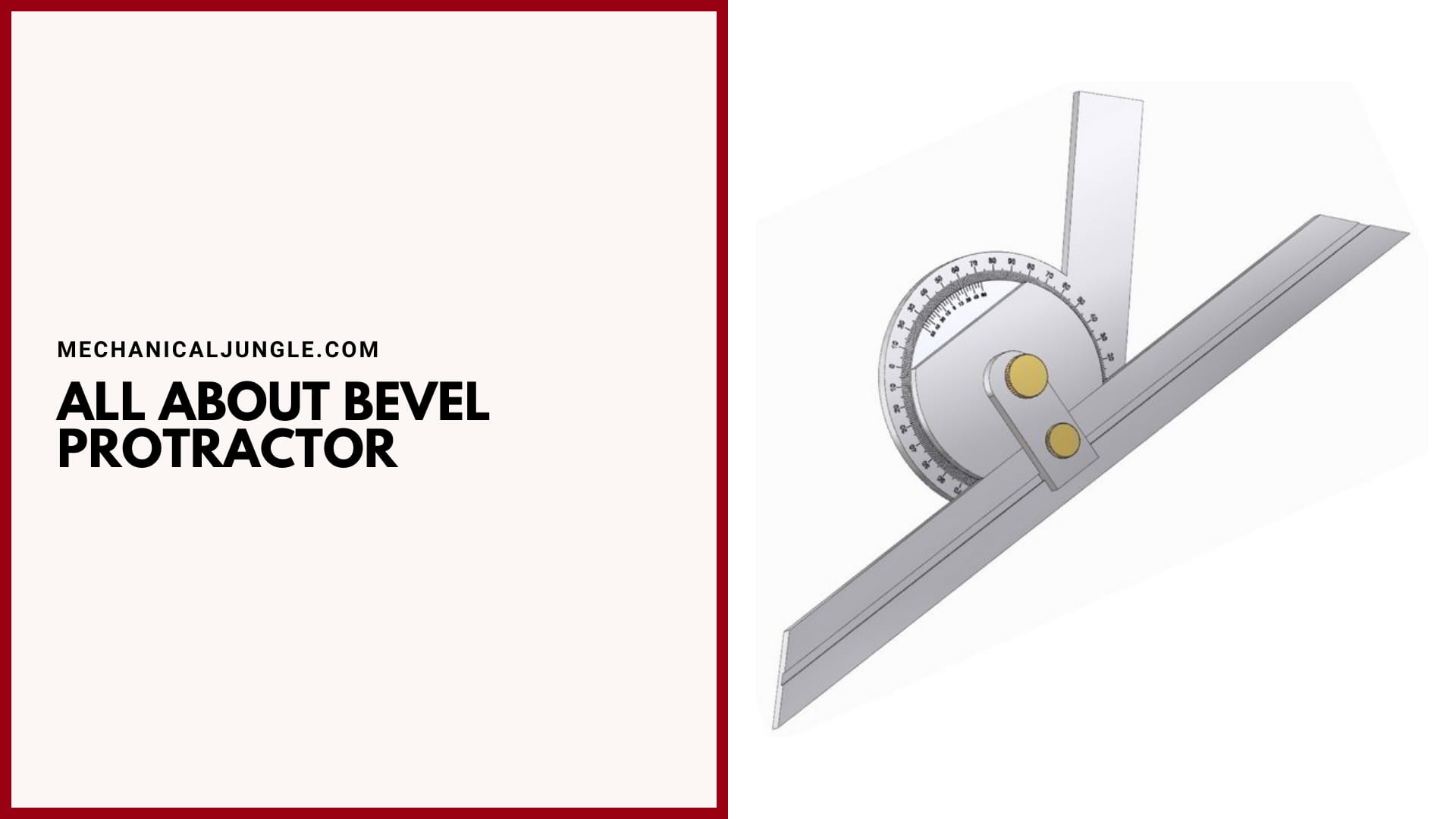
What Is Bevel Protractor?
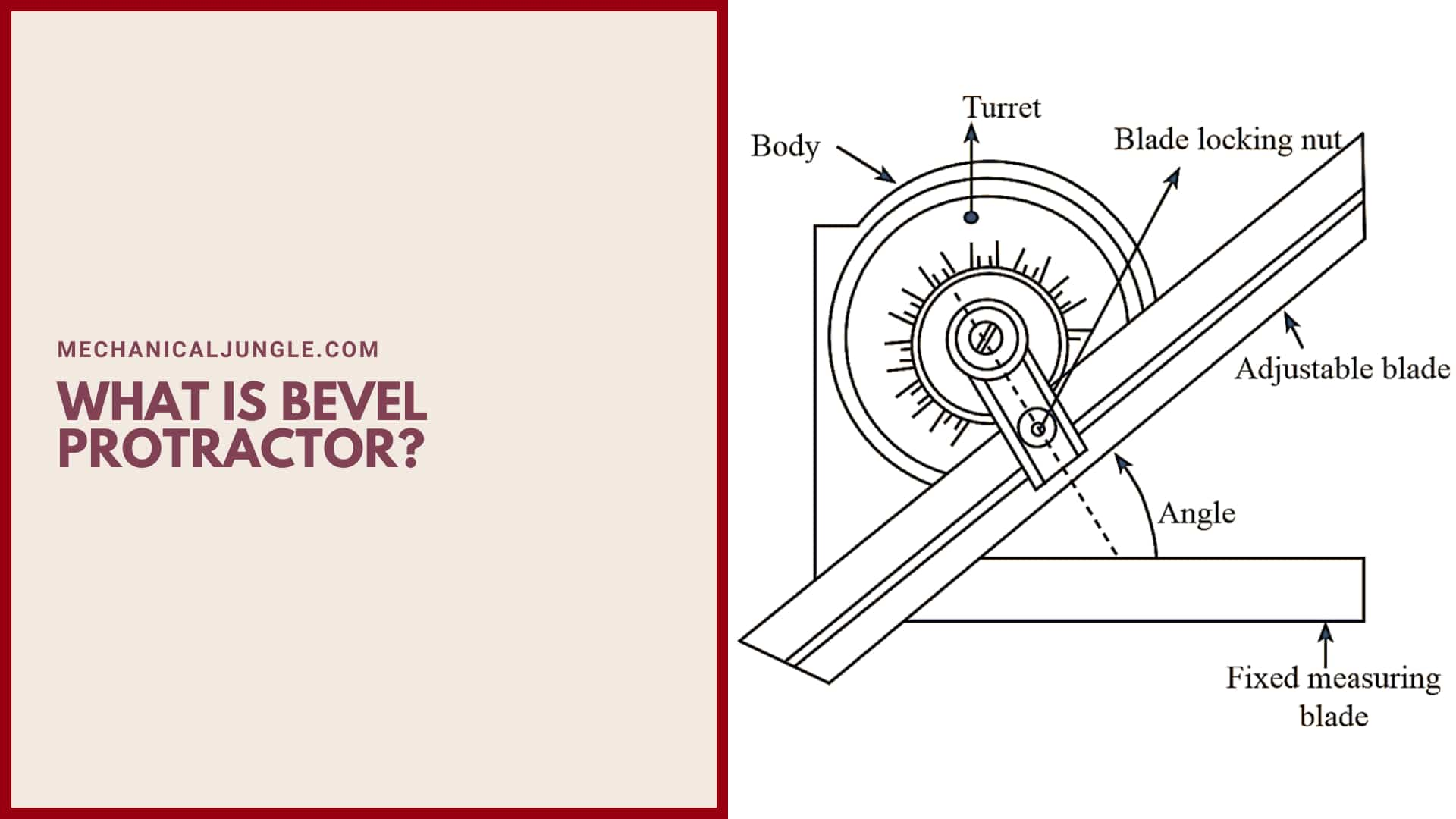
A bevel protractor is a device that consists of a graduated circular scale with a pigmented arm used to measure or make angles. In geometry, a protractor is a spherical or semicircular device that is used to measure an angle or circle. The units measured are normally degrees.
Some protractors are half-discs that have existed since ancient times. A more advanced protractor, such as the bevel protractor, is one or two swinging arms, which help measure the angle.
The device is capable of measuring angles with a minimum count of 5′ or 5 minutes. It is used to measure the angles of any workpiece. It is used for various items such as jigs. Sometimes the bevel protractor is attached to the Vernier scale to give more accurate readings.
Bevel protractor has a very important role in mechanical architectural drawing. The use of software such as CAD is reducing the general use of bevel protractors. Bevel protractors are used to test angles. It is used for various mechanical and engineering-related applications.
Parts of Bevel Protractor:
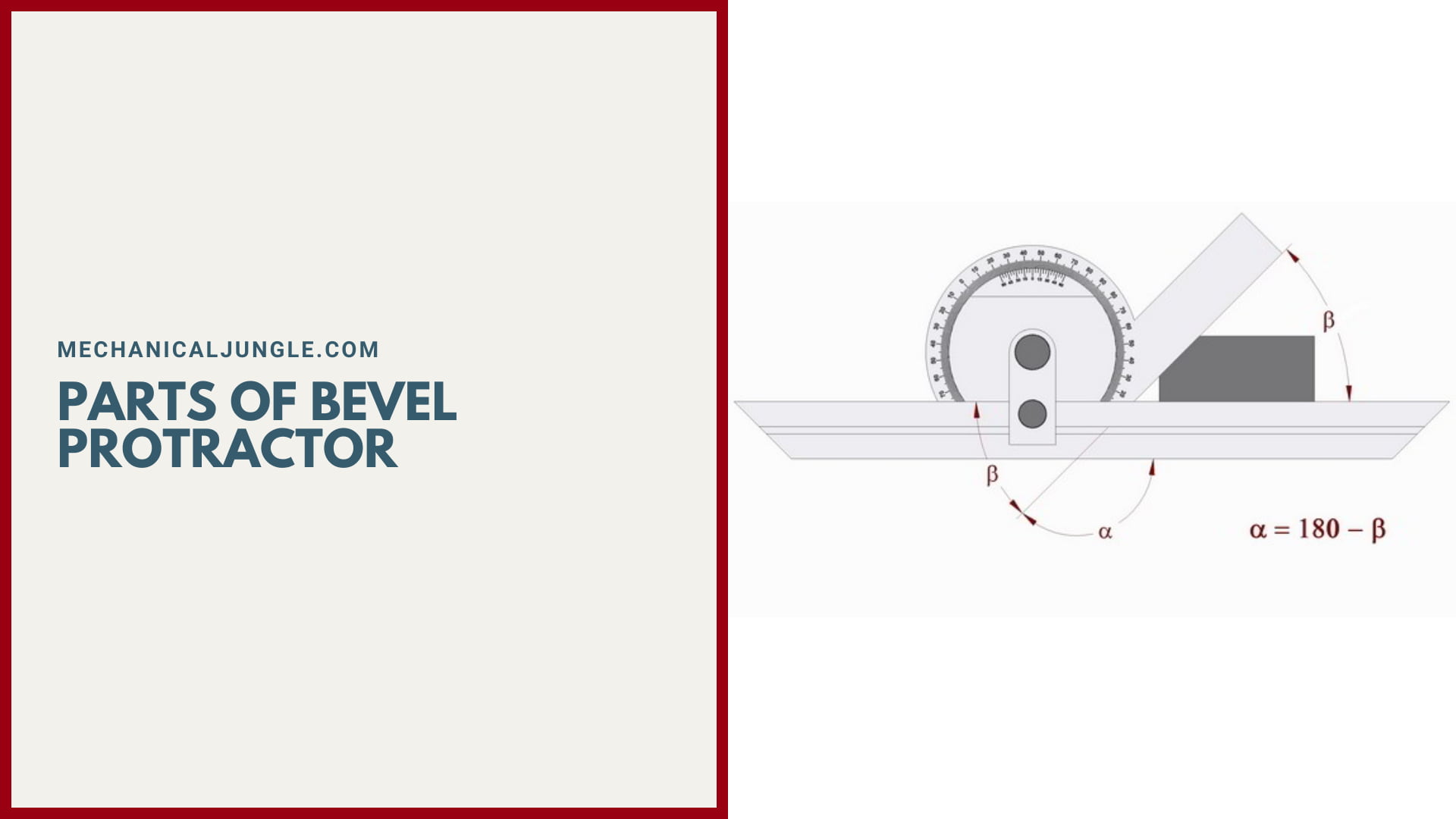
#1. Swivel Plate
The swivel plate rotates on the dial. This swivel plate has a vernier scale that is integrated into it.
#2. Magnifying Glass
A magnifying glass is also present on the version scale in the swivel plate. These magnifying glasses are used to see the value of angles on the main scale and, more clearly, the Vernier scale.
#3. Vernier Scale
The Vernier scales are fixed on the swivel plate, & it moves along the swivel plate. The Vernier scale gives the remaining angle in minutes. There are 60 minutes in 1 degree. It is added to the Vernier scale bevel protractor to increase the accuracy of angle measurement.
In the center, the Vernier scale has a zero. The Vernier scale has 12 partitions on either side of zero, and each division is of 5 minutes. So there’s are 60 minutes on each side of zeros on the Verniers scale.
#4. Angle locking screw
This angle locking screw is used to locks the bevel protractor at a fixed angle so that the locking angle can be measured without any disturbances. This angle prevents the swivel plate from rotating in relation to the locking screw dial or dial scale.
#5. Dial
This is the basis of the bevel protractor on which the other parts are present. The main scale or dial scale is marked on this dial.
#6. Dial Scale
This dial scale is the core of the bevel protractor. It has a graduated level of angle from a value of 0 degrees to 360 degrees. At this graduation, every tenth degree is counted. It is divided into four divisions of 360 degrees, every 90 degrees.
#7. Blade
This blade is made of high carbon steel. This blade is a thin blade. These blades are either 150 mm or 300 mm, depending on the bevel’s protractor. When the blades are parallel to the stock, the zero of the Vernier scale corresponds to the zero of the main scales or the dial scale.
The blade has one end of 45 degrees, and the other has an angle of 30 degrees so that 45 degrees & 30 degrees can be directly measured using these edges.
#8. Blade Lock Screw
Blade locking screws are available to lock the blade at a fixed location. This screw is used when we determine the required length of the blade along the surface of the workpiece.
#9. Stock
The bevel is one of the contact surfaces in the protractor when measuring the stock angle. Stocks are the integrated part of the dial. The dial is also rotated with respect to the blade as it moves, & the angle value changes in the dial scale.
The job or workpieces whose angle is to be measured is placed in contact with this stock on one side. The other side of the job surfaces whose angles are to be measured is placed in contact with the blade. The blade of the bevel protractor goes inside the slot in the stock.
Working of Bevel Protractor:
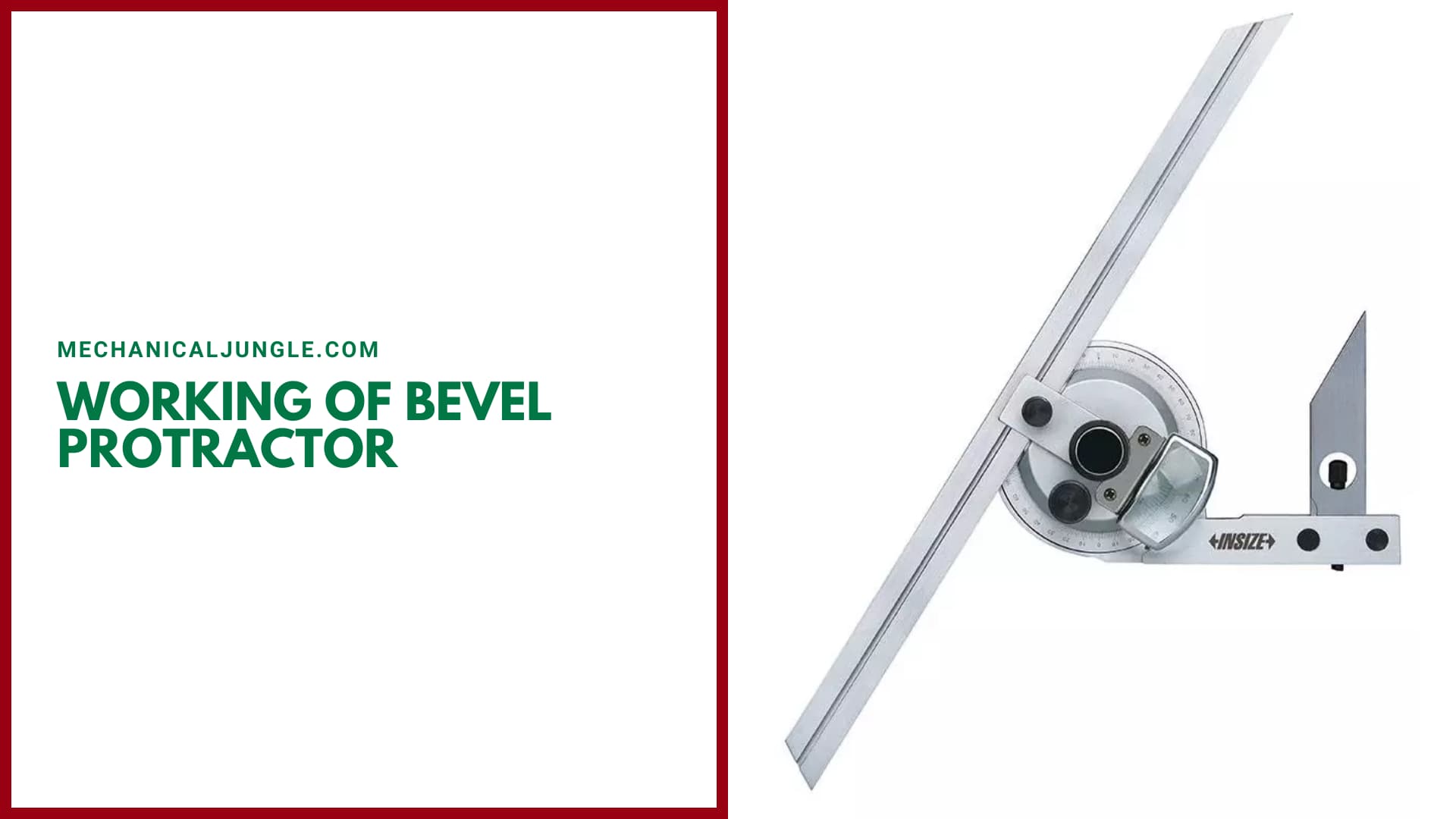
First, the workpiece, whose angles are to be measured, is placed between the blade and the stock of the bevel protractor. One side of the surface measuring the angle is placed in contact with the blade, and the other sides are in contact with the stock.
When the workpiece comes in contact with the blade properly, and the blade is properly placed on the workpiece, the blade is closed using a blade locking screw. After that, when the measured surface comes fully in contact with the stock and blade, the angle is fixed using angle locking screws.
Now we see the values in the main scales, which coincides with the zero of the Vernier scale. The value we read from the main scale gives the angle in degrees. The angle in the main scale, to be more precise, comes just before the zero points of the Vernier scale.
To obtain the angle more accurately, we will now obtain the remaining angle in minutes. To do this, we look at the line of the Vernier scale, which coincides perfectly with the line of the main scale.
After obtaining that line, we see the position of the line in the Vernier scale. Then the minute of the angle measurements is calculated by multiplying the position of the coincident line of the Vernier scale with 5 (five).
Then finally, the angle measured using the bevel protractor is noted in degrees and minutes. Thus, we measure the angle very accurately using a bevel protractor.
Advantages of Bevel Protractor:
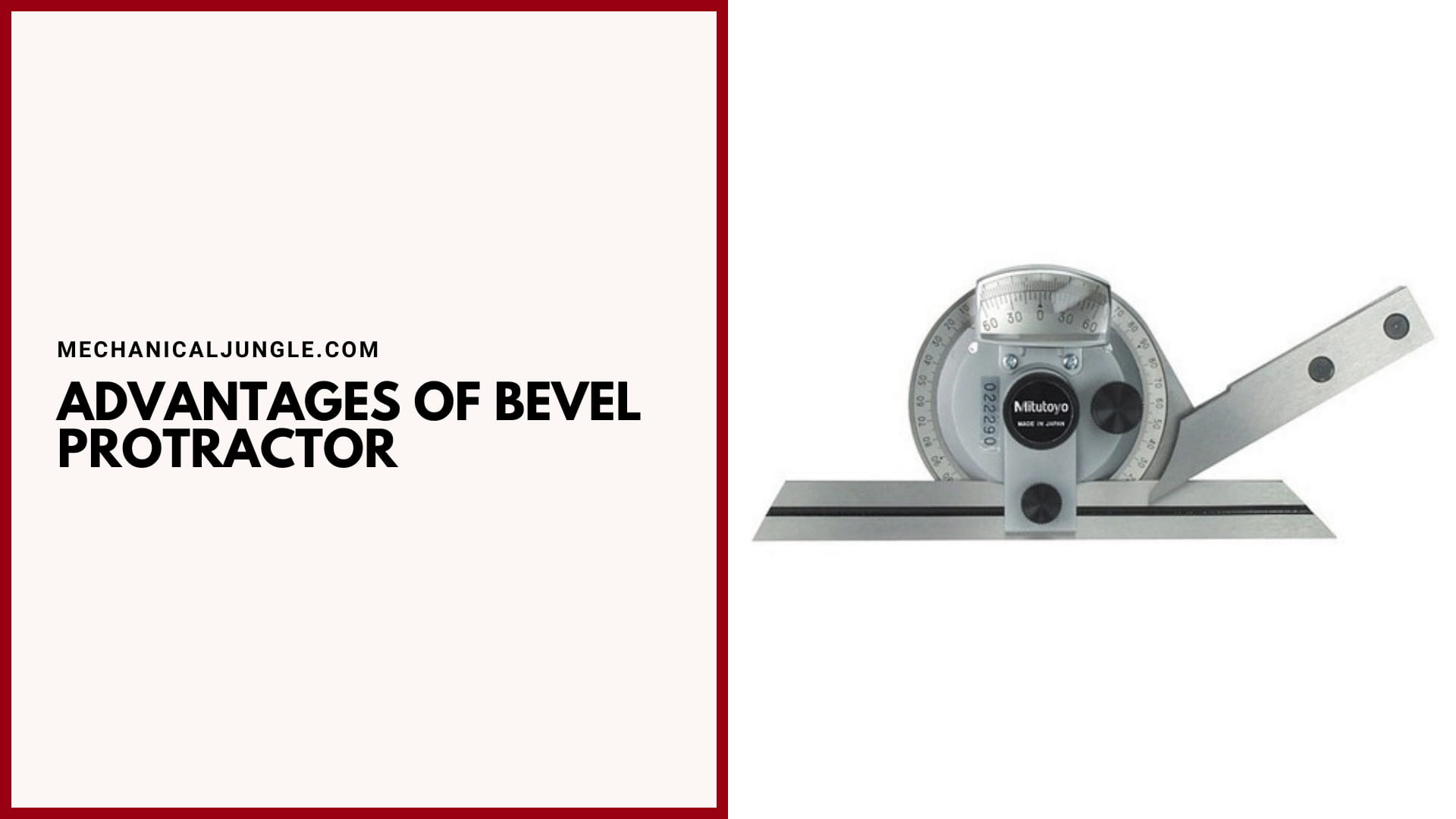
Here, the different Advantages of bevel protractor is as follows:
- It can accurately measure angles up to 5 flatter and can measure angles up to 360 degrees.
- It gives very accurate measurements.
- It is used to set up and test to bear angles in very close proximity.
Applications of Bevel Protractor:

Here, the different Applications of bevel protractors are as follows:
- The bevel protractor is used to probe the V block.
- It is used to examine the bevel face inside the ground surface.
- It is also used to measure acute angles.
Frequently Asked Questions (FAQ)
What Is a Bevel Protractor Used For?
A bevel protractor is used for measuring and setting angles with high precision. It is commonly used in mechanical and engineering applications, as well as in architectural drawing.
How Accurate Is a Bevel Protractor?
A bevel protractor can measure angles with a precision of up to 5 minutes (5′). This level of accuracy allows for precise angle measurement, which is crucial in many technical and engineering tasks.
What Are the Main Parts of a Bevel Protractor?
The main parts include:
- Swivel Plate: Rotates on the dial and includes the Vernier scale.
- Magnifying Glass: Helps in reading the Vernier scale more clearly.
- Vernier Scale: Provides additional precision by measuring minutes of an angle.
- Angle Locking Screw: Locks the bevel protractor at a fixed angle.
- Dial: The base of the bevel protractor with the main scale.
- Dial Scale: Graduated scale for measuring angles from 0 to 360 degrees.
- Blade: Thin, high-carbon steel blade used for measurement.
- Blade Lock Screw: Secures the blade at a specific position.
- Stock: The part in contact with the workpiece to measure the angle.
How Do You Use a Bevel Protractor?
To use a bevel protractor, place the workpiece between the blade and the stock. Adjust the blade to align with the angle of the workpiece, lock it in place with the blade locking screw, and then use the angle locking screw to fix the angle. Read the angle from the main scale and Vernier scale for precise measurement.
Can a Bevel Protractor Measure Angles Beyond 180 Degrees?
Yes, a bevel protractor can measure angles up to 360 degrees, making it versatile for a wide range of applications.
What Are Some Common Applications of a Bevel Protractor?
Common applications include probing V blocks, examining bevel faces on ground surfaces, measuring acute angles, and setting up precise angles in various mechanical and engineering tasks.
How Does a Bevel Protractor Compare to a Digital Protractor?
While both devices measure angles, a bevel protractor provides manual, analog measurements, which can be very precise but may require more skill to use accurately. Digital protractors, on the other hand, offer digital readouts and can provide measurements quickly and with less effort.
Can a Bevel Protractor Be Used in Combination with Other Tools?
Yes, bevel protractors can be used in combination with other measurement tools like calipers and micrometers to enhance precision and achieve more accurate results in various tasks.

